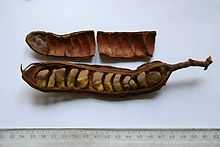Schotia brachypetala
| Schotia brachypetala | |
|---|---|
.jpg) | |
| Scientific classification | |
| Kingdom: | Plantae |
| (unranked): | Angiosperms |
| (unranked): | Eudicots |
| (unranked): | Rosids |
| Order: | Fabales |
| Family: | Fabaceae |
| Subfamily: | Caesalpinioideae |
| Tribe: | Detarieae |
| Genus: | Schotia |
| Species: | S. brachypetala |
| Binomial name | |
| Schotia brachypetala Sond. | |
Schotia brachypetala or Huilboerboon is a leguminous flowering tree in the family Fabaceae (bean family/pod-bearing family/legumes) and the sub-family Caesalpinioideae. It has many common names, including (but not limited to) Weeping boer-bean, Tree fuchsia and African walnut.
Habit
A medium to large, spreading tree, growing up to 20 metres, but more commonly from 5 to 10 metres depending on conditions. Canopy spread can vary between 5 to 15 metres. Trees grown in poor soil or in very dry conditions tend to be smaller (about 5 metres tall with a 5 metre canopy spread) and more sparsely foliaged. Trunk form varies from specimens with single trunks to low-branching specimens with multiple trunks. Leaves are compound, composed of four to eight pairs of leaflets, each with an entire, wavy margin attached to a stem. Bark is smooth and varies from grey to light brown from tree to tree. Flowers are numerous, a deep red, and filled with nectar. Flowers generally appear in Spring, although exact flowering times vary from tree to tree. The fruit is a hard, woody pod about 15 cm long that splits on the tree releasing the seeds, each attached by a fleshy, yellow aril.
Distribution
A native of the southern parts of Africa, mainly sub-tropical. Its northernmost extent is on the edge of the Mashonaland Plateau just south of the Zambezi valley in Zimbabwe at about 17°S. It grows southwards to the eastern parts of South Africa, generally not near the coast but usually on hills away from the coastal winds and further inland. Its southernmost extent is southwest of East London in the Eastern Cape of South Africa at about 33°S. It is a tree of woodland rather than forest.
Ecology
The weeping schotia is nowhere common but is usually scattered among other more dominant woodland trees. It grows best when there is ample summer rain and prefers a notable cool spell during its winter resting period. In Zimbabwe it is widespread at altitudes over 1200 metres in areas with more than 700mm annual rainfall, usually in Brachystegia woodland, while the best specimens grow in the midlands of Kwazulu-Natal at an altitude of about 900–1200 metres. Inland it is usually deciduous, especially where the winter season is very dry or there is risk of frost. The tree gets its new leaves in spring, usually early to mid-September. The new leaves are a very showy bright red as with many savanna trees. The red colour fades through bronze to dark green over a period of 7–10 days. The red flowers are produced straight after the new leaves during September and October and are very attractive to bees. They sometimes produce so much nectar that it drips out of the flowers.
Alternative names

The rarely used name of Parrot Tree derives from the large numbers of parrots attracted to the tree during its flowering season. The common name of Drunken Parrot Tree derives from the fact that the individual flowers contain so much nectar that it has a tendency to ferment before the birds can eat it all, resulting in a mild narcotic effect on the birds. The "Weeping" label in some of its common names refers to the copious quantities of nectar that may rain from the flowers when shaken rather than a tendency of the foliage to "weep" or "droop".
Cultivation
Schotia is an easily grown tree, and is remarkably hardy in both poor soil and very dry conditions. Adverse conditions will affect the growth rate, with poor conditions considerably slowing the speed of growth. In good quality, well-drained soil with plenty of moisture the tree grows very quickly, easily reaching 5 metres within a few years. It is fairly widely cultivated outside its natural range in warm temperate and subtropical climates, particularly in Australia, where it is a common street tree. It has been planted also in Spain.[1]
References
- ↑ Antonio López Lillo & José Manuel Sánchez de Lorenzo Cáceres. Árboles en España: manual de identificación. Mundi-Prensa Libros. S.A. Madrid, España. ISBN 84-7114-957-5
- "Schotia brachypetala". Plantz Afrika. Retrieved 2010-01-21.